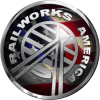Level Crossings
It's been three years since Rail Simulator was first released. The newest iteration of the product, now titled "RailWorks2 TrainSimulator," features the addition of working level crossings. To see the US version, fire up the Barstow to San Bernardino route and drive a train across the University Parkway crossing, 5 miles north of the SB station. The crossing has a pair of warning flasher signals, each with an integral gate. Yes, the flashers are still amber instead of red, but other than that there's nothing to complain about. When a train approaches, the flashers operate and the warning bell sounds. Some ill-mannered motorists will continue to pass through the crossing, but after a brief delay the gates come down and everybody stops. Not long after the train clears the crossing, the gates rise, the flashers turn off, the bell goes silent and everyone continues on their way.
Very nice!
Things like flasher timing and the trigger distances of the train for various actions are controlled by variables in a LUA script which you can easily edit to your liking. It's called lc_us.lua and you can find it in the LevelCrossings folder under RailSimulatorUS.
In this post I'll address how to install a level crossing ("grade crossing" in the US).
Installing a grade crossing is a little tricky. There are several steps and they have to be done properly. All mouse clicks are with the left button except where otherwise noted.
1. In the World Editor, navigate to the grade crossing you want to protect. RS.com has provided a single US-style crossing object that incorporates two each of the familiar BSB signals and gates. This time around, of course, they're animated. You'll find the crossing object labeled "Level Crossing US" under the Track Infrastructure category (semaphore icon) of the Object Tools (house icon). Select it.
2. click somewhere in the intersection. The location is not critical. This sets in place the level crossing's placement gizmo, which is simple a gray box. It also sets out the signals and gates, but probably not where you'll want them. We'll fix that in a bit.
3. Click on each track. That places a double-headed arrow on the track. Again, the exact location isn't critical, but if neatness is your thing, more or less along the center line of the road would be appropriate. Once you have placed arrows on all the tracks, right click (important: right click once only).
4. Click the road on one side of the tracks, again more or less along the center line and about where you want the cars to stop. Now Shift+click the road on the other side of the tracks. Right click. There should now be two single-headed arrows on the road on either side of the tracks. Both arrows should be pointing towards the tracks.
5. Drag and rotate each signal and each gate into place the same way you would for any other scenery object. Right click.
If you mess up along the way, you'll have to delete the whole object and start over. Otherwise you're done!
Note that the right clicks have to be just so: only the three clicks, when and where mentioned here, will work.
In edit mode, when you click on the gray gizmo, you should see something like this:

So can we animate the flasher lights on the gates? Is there any code in the LUA script we can add to or modify to our advantage? Can we add the machinery sound of the gates raising and lowering? Time will tell. The product has only just been released and it will take additional experimentation by the user community to answer these and similar questions. In the meantime, I hope this is enough information to get you going. In a few days I hope to post a brief tutorial for building your own custom crossing object. (I had one ready to go but RS.com changed a few things over the weekend!)
Other Items of Note
Export / Export This
Blueprint Editor users will notice that a new button, labeled "Export This," has been added. According to RS.com, the button exports the current blueprint but none of the referenced blueprints. This was done as a time saver, primarily for complex models with many blueprints such as steam locomotives. In most cases, "Export" will suffice.
Access to the World Editor
In RW2 the fly-out (fly-up?) panel at the bottom of the screen is gone! To get into the World Editor in a free roam scenario you have to click on a locomotive (one with a Driver, that is), click on the X button on the new user interface, and select World Editor from the black menu. What a pain!
Well not really. You can simply use the Ctrl+E shortcut. Actually, it was there before the advent of RW2, but not everybody, including me, knew about it.


